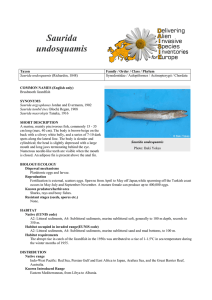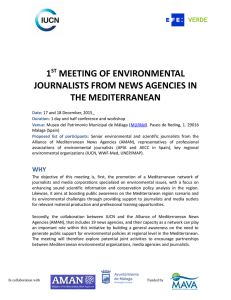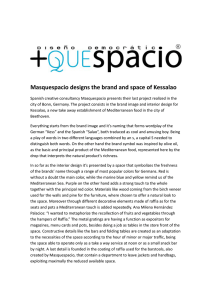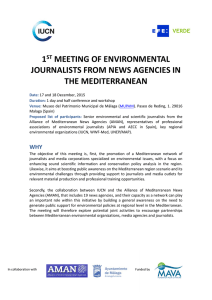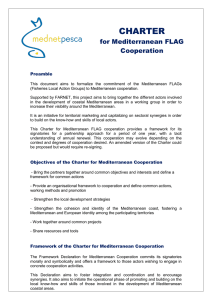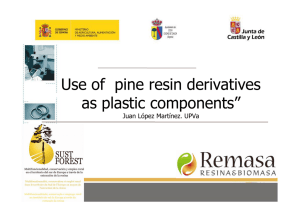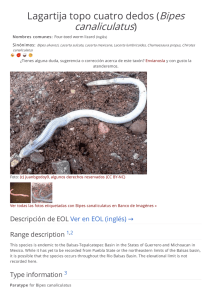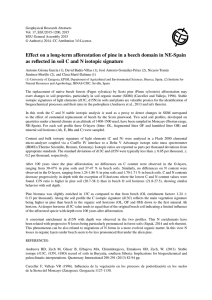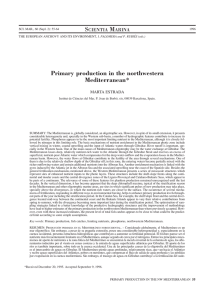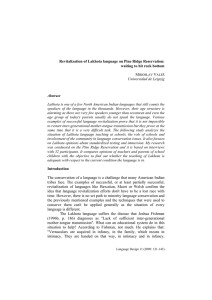oxygen transport and blood buffering capacity in the
Anuncio
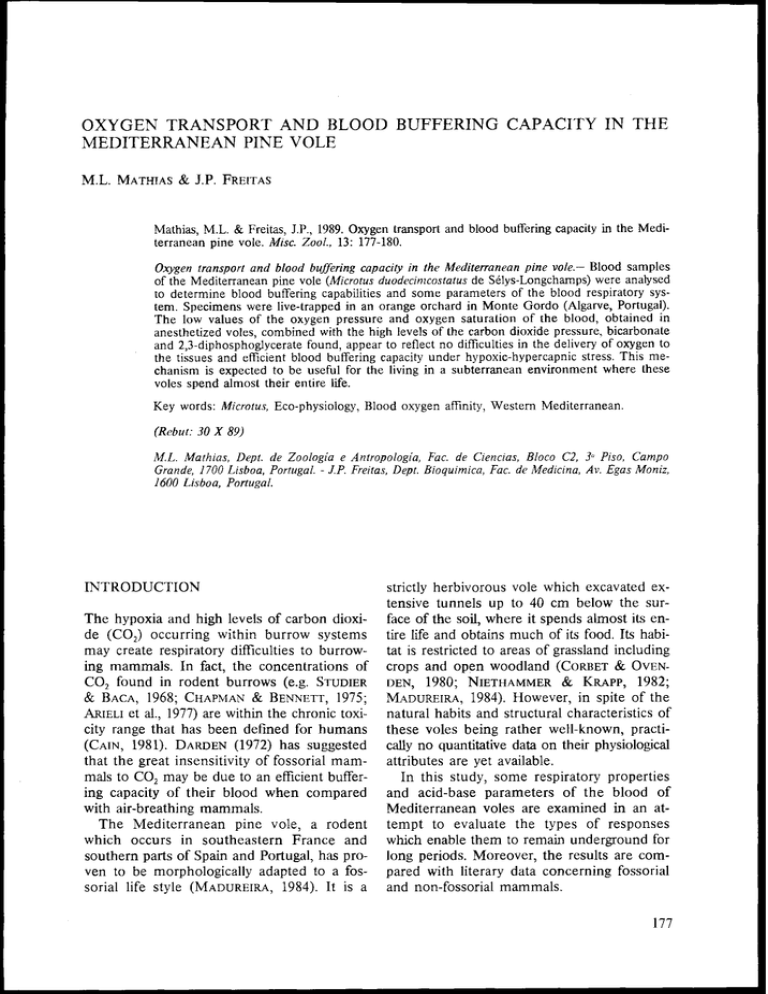
OXYGEN TRANSPORT AND BLOOD BUFFERING CAPACITY IN THE MEDITERRANEAN PINE VOLE M.L. MATHIAS & J.P. FREITAS Mathias, M.L. & Freitas, J.P., 1989. Oxygen transport and blood buffering capacity in the Mediterranean pine vole. Misc. Zool., 13: 177-180. Oxygen transport and blood buffering capacity in the Mediterranean pine vale.- Blood samples of the Mediterranean pine vole (Microtus duodecinzcostatus de Sélys-Longchamps)were anaiysed to determine blood buffering capabilities and some parameters of the blood respiratory system. Specimens were live-trapped in an orange orchard in Monte Gordo (Algarve, Portugal). The low values of the oxygen pressure and oxygen saturation of the blood, obtained in anesthetized voles, combined with the high levels of the carbon dioxide pressure, bicarbonate and 2,3-diphosphoglycerate found, appear to reflect no dificulties in the delivery of oxygen to the tissues and efficient blood buffering capacity under hypoxic-hypercapnic stress. This mechanism is expected to be useful for the living in a subterranean environment where these voles spend almost their entire iiie. Key words: Microtus, Eco-physiology, Blood oxygen affinity, Western Mediterranean. (Rebut: 30 X 89) M.L. Mathias, Dept. de Zoología e Antropología, Fac. de Ciencias, Bloco C2, 3 Piso, Campo Grande, 1700 Lisboa, Portugal. - J.P. Freitas, Dept. Bloquimica, Fac. de Medicina, Av. Egas Moniz, 1600 Lisboa, Portugal. strictly herbivorous vole which excavated extensive tunnels up to 40 cm below the surThe hypoxia and high levels of carbon dioxi- face of the soil, where it spends almost its ende (CO,) occurring within burrow systems tire life and obtains much of its food. Its habimay create respiratory dificulties to burrow- tat is restricted to areas of grassland including ing mammals. In fact, the concentrations of crops and open woodland (CORBET& OVENCO, found in rodent burrows (e.g. STUDIER DEN, 1980; NIETHAMMER & KRAPP, 1982; & BACA, 1968; CHAPMAN & BENNETT,1975; MADUREIRA, 1984). However, in spite of the ARIELIet al., 1977) are within the chronic toxi- natural habits and structural characteristics of city range that has been defined for humans these voles being rather well-known, practi(CAIN, 1981). DARDEN(1972) has suggested cally no quantitative data on their physiological that the great insensitivity of fossorial mam- attributes are yet available. mals to CO, may be due to an efficient bufferIn this study, some respiratory properties ing capacity of their blood when compared and acid-base parameters of the blood of with air-breathing mammals. Mediterranean voles are examined in an atThe Mediterranean pine vole, a rodent tempt to evaluate the types of responses which occurs in southeastern France and which enable them to remain underground for southern parts of Spain and Portugal, has pro- long periods. Moreover, the results are comven to be morphologically adapted to a fos- pared with literary data concerning fossorial sorial life style (MADUREIRA, 1984). It is a and non-fossorial mammals. MATERIAL AND METHODS 1. Experimental animals Twenty-four adult specimens (1199 and 1388) ranging in body mass from 21.50 to 33.29 g were used. Al1 of the specimens were live-trapped at the entrances of their burrows, in an orange orchard in Monte Gordo (Algarve, Portugal). The voles were housed in smail-sized terraria partly filled with soil. Air temperature was kept close to that of the outside, with natural photoperiod. Voles were fed apples, carrots, potatoes and water ad lib. No body mass loss was observed during this period. The experiments were conducted from September to December 1985. Ail measurements were made within two days of capture. rectly by ultrasound, using an oximeter OSM 2 (Radiometer, Copenhagen), according to the method of SIGGARD-ANDERSEN (1977). Erythrocyte concentrations of 2,3-diphosphoglycerate (2,3-DPG) were assayed from extracts, deproteinized with trichloroacetic acid immediately after the blood sampling, with a commercial enzymatic test kit (BoehringerMannhein) (HELLERSTEIN & BUNTHRARUNGROJ,1976; SAMAJAet al., 1983). Oxygen pressure (PO,), carbon dioxide pressure (PCO,), pH, base excess (B.E.) and bicarbonate concentration (HCO?) were measured in duplicate, at 37 OC, with standard electrodes for blood gas and pH, in a IL 1302 pHIBlood Gas Anaiyser. Due to the small amount of blood sampled from each vole not al1 of these anaiyses were conducted in each specimen. 2. Blood analysis RESULTS Ail the analyses were made during daytime, almost without exception between 1490 and 16:OO hours. The voles were anesthetized with ether and within the filst minute of anesthesia mixed venous blood was drawn, by cardiac puncture, into heparinized syringes. Approximately 0.35 m1 of blood was taken from each animal. The blood samples for pH and gas analyses were kept anaerobicaiiy on ice, into a closed syringe, until determination. Analyses were initiated immediately after sampling and completed within 2 hours of blood withdrawal. Hemoglobin concentration (Hb) and oxygen saturation of the blood (SO,) were measured in duplicate by photometry of a capillary fraction hemolysed di- Physiological characteristics of the blood of M. duodecimcostatus are summarized in tables 1 and 2. Table 1. Hemoglobin (Hb) and 2,3-diphosphoglycerate (2,3-DPG) values of ten Mediterranean pine voles. X. Mean; S.D. Standard deviation. Valores de hemoglobina (Hb) y 2,3-difosfoglicerato (2,3-DPG) de diez topillos comunes. X. Media; S.D. Desviación estandar. Hb (g%) X S.D. 13.58 1.10 DPG DPG (pmoles/ml) (pmoles/g Hb) 3.50 0.95 25.43 5.55 Table 2. PO,, SO, and acid-base status of the blood of Microtus duodecimcostatus. X. Mean; S.D. Standard deviation; n. Number of voles. PO,, SO, y estatus acido-base de la sangre de M . duodecimcostatus. X. Media; S.D. Desviación estandar; n. Numero de especímenes. X S.D. n so2 PO, (mm Hg) PH (Ola) 25.97 19.14 10 27.61 13.30 15 7.19 0.09 15 PCO, (mm Hg) 86.57 16.35 15 HCO; (m~/l) 32.98 5.32 15 B.E. (mM/l) 2.28 5.62 15 DISCUSSION ciation curve seems to be similar to the one reported in low-altitude animals kept for long periods at high altitude (e.g. JOHANSEN et al., 1976; AR et al., 1977). 1. Respiratory properties of blood The average hemoglobin value in the Mediterranean pine voles blood (13.58 I1.10 gO/o) is similar to that in normoxic rat or other air- 2. Blood buffering capacity breathing small mammals blood (e.g. MITRUKA & RAWNSLEY, 1981). The average PCO, in the blood of the MediSTUDIER & BACA(1968) have suggested that terranean pine voles as weií as the high HCO; a high PCO, in the blood of subterranean ro- concentration values found, suggests an elevadents, as a consequence of high carbon dioxi- ted buffering capacity of the blood in these de levels in burrows, may lead to a respiratory animals. This is probably a response of the acidosis or a Bohr-shift of the blood-oxygen blood buffer system which protects the indidissociation curve suficient to compensate the vidual~from CO, retention and from a dehypoxia which might result from the lower cresing in the pH of venous blood (table 2). oxygen tensions. The average value of blood The average bicarbonate concentration CO, pressure found (86.5.7 k 16.35 mmHg) is found in M. duodecimcostatus (32.98k5.32 very high when compared, for instante, with mM11) is higher than in humans (27.0 mMIl), values for mice (40.0 5.4 mmHg) or rats rabbits (18.0; 22.8 mM11) or rats (19.8 mM11) (42.0 I 5.7 mmHg) (MITRUKA& RAWNSLEY, (CHAPMAN & BENNETT,1975). 1981). However, the occurrence of a short The Mediterranean pine voles, in spite of period of hypoventilation, less than one minu- spending the major part of the day underte, between anesthesia and blood sampling can ground, also spend each day a certain amount not be excluded. On the other hand, the re- of time on the surface. They seem to be able sults show a low average SO, (25.97 19.140/0), to support and adjust their blood respiratory even for venous blood, compared with blood capability to marked difFerences in the gaseous PO, (27.61 13.30 mmHg). Assuming an ave- atmosphere of their surrounding environment. rage n = 2.5 for Hill coeficient we obtain a Data obtained through the blood analyses P50 in vivo of approximately 41.7 torr. Howe- performed in M. duodecimcostatus as the low ver, when corrected for the low pH observed, PO, and SO, values, suggest the adaptability assuming a Bohr effect of -0.5 P50, at pH of of these rodents to hypoxia. Moreover, the 7.4 a value of P50 standard near 33.4 torr high PCO, agree with the idea of a certain in(SEVERINGHAUS, 1966; ABERMANet al., 1975) sensitivity of these small mammals to CO, was found. which can be likely explained by the high The low average SO, which was obtained blood buffering capacity of their blood as assuggests that the operating range for the oxy- sayed by the bicarbonate content found gen equilibrium curve, in this particular ex- (32.98 f5.32 mM11). On the other hand as the periment, corresponds to less than 50 Oo/ satu- pH of mixed venous blood is rather low ration. (7.19 +0.09), the possible existence of a diMoreover, the 2,3-DPG levels found in the minished sensitivity of the respiratory control blood of M. duodecimcostatus are very high receptors, which react to low pH, could also (3.50k0.95 pmol/ml), when compared to be imporíant. those found for other small mammals (e.g. Their adaptive mechanism to hypoxia and AR et al., 1977). This suggests a low oxygen rathter low PO, is also interesting. The high afinity in vivo which may facilitate the deli- levels of 2,3-DPG (3.50 10.95 pmollml) togevery of oxygen to the tissues during the per- ther with the low pH and high PCO, values manence within burrows. This adaptation and found, will cause a shift to the right of the the corresponding right-shifted oxygen disso- blood-oxyhemoglobin dissociation curve, in I + + + l Misc. Zool. 13. 1989 situations of hypoxia or hypercapnia, increasing the oxygen supply to tissues. Results suggest that the respiratory strategy used by the Mediterranean pine voles to maintain an adequate oxygenation can be based in the high concentration of red cell 2,3-DPG which seems to be the main parameter controlling the supply of oxygen to the tissues. RESUMEN Transporte de oxígeno y capacidad tampón en la sangre del topillo común. En este trabajo se analizan algunos parametros de la sangre de Microtus duodecimcostatus para determinar la capacidad tampón y el sistema de transporte de oxígeno. Este topillo que vive en galerías puede soportar grandes variaciones de la composición gaseosa circundante. La estrategia respiratoria que permite a este topi110 vivir en ambientes con oxígeno insuficiente, puede basarse en la alteración de la curva de disociación del oxígeno, y a la regulación del equilibrio ácido-base (tabla 2). La concentración de 2,3-DPG de los glóbulos rojos será el principal parámetro en el control del desvío directo de su curva de disociación (tabla 1). REFERENCES ABERMAN, A., CANAVILLES, J.M., WEIL, M.H. & SHUBIN, H., 1975. Blood P50 calculated from a single measurement of pH, PO, and SO,. J. Appl. Physiol., 38: 171-176. AR, A., ARIELI, R. & SHOLNIK, A,, 1977. Blood-gas properties and function in the fossorial mole rat under normal and hypoxic-hypercapnic atmospheric conditions. Respiration Physiology, 30: 201-218. ARIELI,R., AR, A. & SHKOLNIK, A,, 1977. Metabolic responses of a fossorial rodent (Spalax ehrenberto simulated burrow conditions. Physiological ~oology,50: 61-75. CAIN.S.M.. 1981. Svmoosium on Blood Oxvgen Affiiity as'a facto; 'i tissue oxygen deliviyy. The ~ h ~ i i o l o ~ 25: i s t ,87-90. CHAPMAN, R.C. & BENNETT, A.F., 1975. Physiological correlated of burrowing in rodents. Comp. Biochem. Physiol., 51A: 559-603. CORBET,G. & OVENDEN, D., 1980. The Mammals of Britain and Europe. Wm. Collins Sons & Co. Ltd, Glasgow. DARDEN, T.R., 1972. Respiratory adaptations of a fossorial mammal, the Pocket gopher (Thomomys bottae). J. Comp. Physiol, 78: 121-137. T., 1976. EfHELLERSTEIN, A. & BUNTHRARUNGROJ, fect of time and temperature on blood PSO and 2,3-Diphosphoglycerate measurements. Clinical Chemistry, 22: 39-41. K., LYKKEBOE, G., WEBER,R.E. & MAJOHANSEN, LOIY,G.M.O., 1976. Blood respiratory properties in the naked mole rat Heterocephalus glaber, a mammal of low body temperature. Respiration Physiology, 28: 303-314. MADUREIRA, M.L., 1984. A Biologia de Microtus (Pitymys) duodecimcostatus de Sélys-Longchamps, 1839 e M.(P.) lusitanicus Gerbe, 1879 em Portugal: taxonomia, osteologia, ecologia e adapta~óes. Ph. D. Thesis, Universidade de Lisboa. MITRUKA, B. & RAWNSLEY, H., 1981. Clinical, Biochemical and Hematological Referente Values in Normal Experimental Animals and Normal Humans (2nd. ed.). Masson Publishing USA, New York. NIETHAMMER, J. & WP, F. (eds.), 1982. Handbuch der Saugetiere Europas, Band 211, Nagetiere 11. Akademische Verlagsgessllschaft. Wiesbaden. SAMAJA,M., M E L O T ~ , D ROVIDA, ., E. & ROSSIBERNARDI, L., 1983. Effect of temperature on the PSO value for human blood. Clinical Chemistry, 29: 110-114. SEVERINGHAUS, J.W., 1966. Blood gas calculator. J. Appl. Physiol., 21: 1108-1 116. SIGGARD-ANDERSEN, O., 1977. Experiences with a new direct-reading Oxygen Saturation Photometer using ultrasound for hemolyzing the blood. Scand. J. Clin. Lab. Znv., 146: 45-50. STUDIER, E.H. & BACA,T.P., 1968. Atmospheric conditions in artificial rodent burrows. The Southwestern Naturalist, 13: 401-410. gi)
